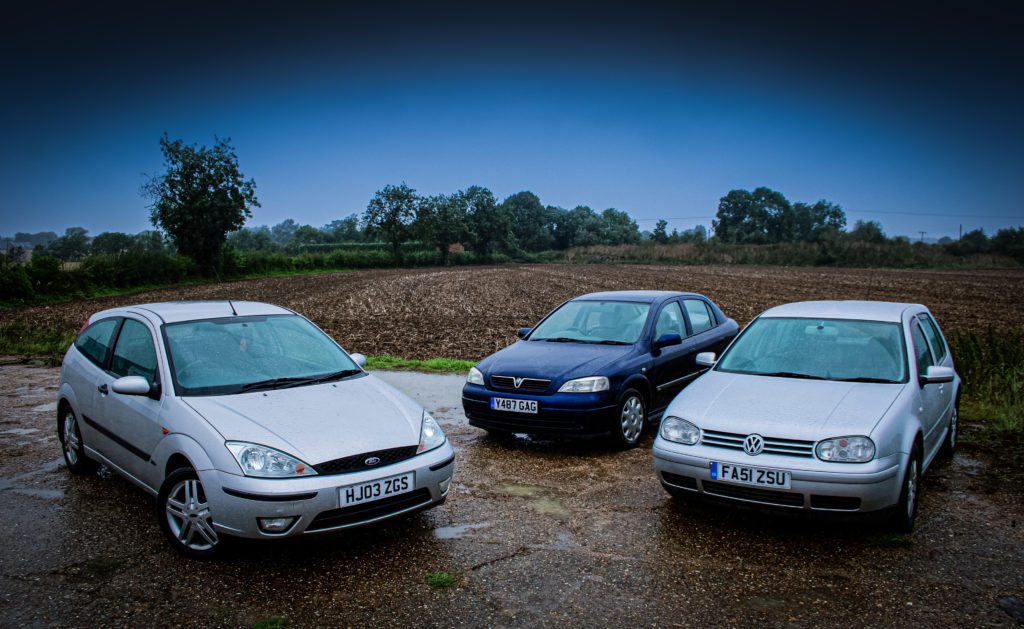Astra, Focus & Golf – Coming of Age

[vc_row][vc_column][vc_column_text]We’ve partnered up with Retro Cars magazine to bring you some of their content from past editions. Plus, we get to do a column in each new magazine, so make sure you pick it up from the shelves, or get yourself a subscription! You can find all the details about the magazine, and subscription by clicking these tasty words.
Anyway, on with the story, in which Craig Cheetham and Tom Barnard look to decided which is best out of the late ’90s Golf, Astra and Focus.[/vc_column_text][/vc_column][/vc_row][vc_row][vc_column][vc_single_image image=”6117″ img_size=”full” alignment=”center” onclick=”img_link_large” css_animation=”appear”][/vc_column][/vc_row][vc_row][vc_column][vc_column_text]If you were looking for a compact family hatchback in the early Nineties, the options were often insipid.
There were a couple of gems – the Peugeot 306, Citroen ZX and Rover 200 ‘R8’ were all decent to drive, but three of the biggest sellers were average at best. The Mk 3 Vauxhall Astra was cleanly styled and decent to drive (if you avoided the 1.4 Hi-Torq and normally-aspirated diesels) but had a dreary cabin, the VW Golf Mk 3 lagged behind its predecessor in everything from build quality to chassis dynamics and the Mk 5 Ford Escort was let down by a choppy ride, dull handling and a range of massively outdated (and noisy) engines.
But in 1998, there was a sea change as all three were replaced by new cars that represented an unbelievable advance.
First up was the VW Golf, revealed at the 1997 Frankfurt Motor Show and sold in the UK from January 1998. It marked a significant return to form for VW, with handsome lines, a chunky, stylish cabin and vastly improved dynamics.
Vauxhall was next off the block, the Astra Mk 4 making its debut at the 1998 Geneva Show. As with the previous model the range was bewilderingly vast and you had to choose which model you wanted carefully, but with a galvanised body shell and a massive focus on ride and refinement, it was leagues ahead of the Mk 3.
Speaking of Focus, Ford elected to drop the Escort name for the car’s successor – a massive and bold move which showed the depth of changes. It was first shown as a concept car at the same Geneva show where the Astra made its debut, and went on sale the following September to coincide with the all-new S-plate registrations.
The car was a sensation – striking to look at, great to drive and such a massive advance over the car it replaced that the media went potty, showering it with praise, awards and masses of hype.
Back in 1998, the Astra v Focus v Golf group test was a staple of the automotive media, with every major title group testing the three, and unanimously agreeing that while all were decent cars, the Focus was the best.
But now this trio have turned 21 and early examples of any of them are rare. When viewed as retro classics, is the Focus still the winner, or has two decades of experience seen a different kind of quality shine through?
To find out, Retro Cars put all three of them together for the first time since the early 2000s and, to see which was best, wheeled out two motoring writers who group tested them first time round – editor Craig Cheetham and associate editor Tom Barnard.
But which would win – and would the two retro road testers agree?
The Volkswagen Golf Mk4…
[/vc_column_text][/vc_column][/vc_row][vc_row][vc_column][vc_single_image image=”6115″ img_size=”full” alignment=”center” onclick=”img_link_large” css_animation=”appear”][vc_single_image image=”6106″ img_size=”full” alignment=”center” onclick=”img_link_large” css_animation=”appear”][/vc_column][/vc_row][vc_row][vc_column][vc_column_text]The Golf was the first of our trio to appear and was, for a short while, the absolute hero of the compact hatchback class. When you consider it was being sold alongside the Mk 3 Astra, Renault Megane, Escort Mk 6 and Rover 400, its appeal is easy to recognise.
It wasn’t the most adventurous design, but that was in many ways part of its appeal. It was instantly identifiable as a Golf, and VW (as usual) came up with a brilliant TV marketing campaign, with various modified examples shedding tears from their ‘teardrop’ headlamps at their owners’ vain attempts to ‘improve’ them. ‘Some things are best left alone’, said VW – and it was right.
Even in base spec, the Golf was a very nice thing. The interior was its trump card, with a feeling of solidity and quality that no other compact car could match. Indeed, even today, there are mid-size cars that fail to feel as satisfying as the Mk 4 Golf. It not only had chunky, high quality controls, but also had wonderful indigo-coloured dashboard lighting.[/vc_column_text][/vc_column][/vc_row][vc_row][vc_column][vc_single_image image=”6112″ img_size=”full” alignment=”center” onclick=”img_link_large” css_animation=”appear”][vc_single_image image=”6109″ img_size=”full” alignment=”center” onclick=”img_link_large” css_animation=”appear”][/vc_column][/vc_row][vc_row][vc_column][vc_column_text]It didn’t matter, then, that the engine range was getting on a bit, with the base 1.4, the 8v 1.6 (there was also a much more modern 16v unit) and the 8v 2.0 able to trace their roots back to the Golf Mk 2. There were more advanced options – a 1.8-litre 20-valve turbo and a 2.3 litre V5 that was prone to knocking its sump clean off on speedbumps – but these weren’t the stalwarts of the range.
Then there was the diesel – VW’s 1.9-litre unit was a proven design that continued to evolve, and in the Golf Mk 4 it gained direct injection which made it smoother and more responsive. There was a non-turbo model in the form of the glacially slow SDI, and three levels of boost on the turbo models – 90, 110 and 130bhp. An even quicker 150bhp version appeared later and was initially badged GTD – one of the first diesel ‘warm’ hatches, though the honour of being the very first belongs to the Citroen ZX Volcane.
Until BMW’s iteration of the MINI appeared three years later, the Golf was the car of choice for the aspiring middle classes, so much so that the 2.0-litre GTI was lambasted by performance car fans for being a lukewarm hatch for estate agents that wasn’t true to the nameplate.
And that’s what we have here – a five-door 2.0 GTI. Ironically, the Golf that was seen as furthest from the mark when new is one of the best options today; its old-fashioned powertrain proving dutifully reliable and easily capable of over 200,000 miles. It’s a dependable unit and reasonably economical; while it lacks urge it’s torquey and responsive. Show it a twisty road and cracks in the Golf’s dynamics start to show – of the three cars here, it’s the least dynamically rewarding with lifeless steering which make it feel remote from the road. But it’s comfortable, well-insulated, refined and still feels classy – not something that can be said of its rivals.
Over time, the Mk4’s perceived quality started to wobble. Electrical maladies, worn seats and corrosion all playing a part. Indeed, the Golf is quite rust prone, especially around the front end where VW put foam blocks inside the wings to aid sound insulation – they also absorb moisture and rot the wings out.
It still feels like a quality car, though, and is arguably the most handsome of the trio.
The Vauxhall Astra Mk4…
[/vc_column_text][/vc_column][/vc_row][vc_row][vc_column][vc_single_image image=”6114″ img_size=”full” alignment=”center” onclick=”img_link_large” css_animation=”appear”][vc_single_image image=”6102″ img_size=”full” alignment=”center” onclick=”img_link_large” css_animation=”appear”][/vc_column][/vc_row][vc_row][vc_column][vc_column_text]GM’s management must have been rather concerned at the 1998 Geneva Motor Show, when across the halls Ford pulled the wraps off the Focus concept car, with its edgy lines and thrusting, modern appearance.
For although the Mk 4 Astra was by far the best European car the company had launched in years, it was an abject lesson in conservatism. It was clean and tidily styled (if you ignored the clumsy saloon model), but was hardly a car to set pulses racing.
Vauxhall didn’t help matters, either, by being quite stingy with the spec sheet. The entry-level ‘Envoy’ managed to take a good car and make it look utterly miserable, with drilled steel wheels and black rubbing strips.
Things got better further up the range, but even in posher examples the cabin was fairly plain. Less special than the Golf, less interesting than the Focus and greyer than Spitting Image’s rendition of John Major.
The base engine was an eight-valve 1.6 with 95bhp, followed by a 100bhp 1.4 16v and a 110bhp 1.6 16v. The 1.8, with 127bhp, was a bit of a sleeper, while the proven Isuzu 1.7 diesel was also offered. Later on came a 145bhp 2.2-litre and a 197bhp 2.0 turbo with some decent performance, but it was Vauxhall’s fleet bread and butter that made it the money, so was the core focus.[/vc_column_text][/vc_column][/vc_row][vc_row][vc_column][vc_single_image image=”6113″ img_size=”full” alignment=”center” onclick=”img_link_large” css_animation=”appear”][vc_single_image image=”6103″ img_size=”full” alignment=”center” onclick=”img_link_large” css_animation=”appear”][/vc_column][/vc_row][vc_row][vc_column][vc_column_text]Our test car is lower down the ladder than the Golf and Focus we have here – a 1.6 Club, which was the mid-range retail prospect, very similar in specification to the fleet-focused LS, but with showroom-friendly options such as air conditioning and an upgraded stereo (long since replaced in our example).
It may not have felt like the best made car in this trio when new, but the Astra was a thoroughly developed and well-engineered car, with a galvanised body and excellent fit and finish, neither of which could offset its reputation as being a bit boring.
In hindsight, though, to say it was dull is a trifle unfair. It might not have been a looker, but the Astra was a surprisingly good car on the road, with excellent body control, decent steering and a comfortable ride. It also feels the freshest of our three test cars to drive. All have six-figure mileages, but the Astra still feels tight and responsive, with only a creaky driver’s seat showing its age. Otherwise, it feels like a car with plenty of life left in it and one that’s more than capable of mixing it with modern traffic.
In terms of reliability, the Astra has acquitted itself well over the years. With the notable exception of the 2.2, which is prone to cam chain tensioner failure, the rest of the engine range is sturdy and long-lived. As, too, is the bodywork. Cosmetic rust on the rear arches is common, but rarely will the Astra be haunted by structural rot.
The Ford Focus Mk1…
[/vc_column_text][/vc_column][/vc_row][vc_row][vc_column][vc_single_image image=”6116″ img_size=”full” alignment=”center” onclick=”img_link_large” css_animation=”appear”][vc_single_image image=”6098″ img_size=”full” alignment=”center” onclick=”img_link_large” css_animation=”appear”][/vc_column][/vc_row][vc_row][vc_column][vc_column_text]Of the three cars featured here, it’s the Focus that achieved the most column inches when new.
The PR behind its launch was masterful, with Ford drip-feeding details about the car from the prototype’s appearance in Geneva to the official launch in September, each chapter in the story building up to the final fanfare.
And the motoring media weren’t disappointed. All of the hype was justified, from the ‘New Edge’ design to the ‘Control Blade’ rear suspension, Ford had rewritten the compact hatchback rulebook. To go from the mediocre Escort to the best small family car in a generation was a seismic shift and enough to win the Ford the 1999 European Car of the Year accolade – something it richly deserved. Even the stereo was excellent.
The petrol engines were all superb – 1.4, 1.6 and 2.0-litre derivatives of the brand’s Zetec engine family, which debuted in the Mondeo. The diesel, though, was its weakest link. The 1.8-litre direct injection unit was noisier, less refined and less economical than most of its rivals. It ticked a box for fleet customers, but unless you needed the frugality of an oil-burner, the petrol models were a much more attractive prospect.
The car we have here is a 2.0 Zetec – a car that was spoken about in hushed tones when new, as its 140bhp engine truly exploited the Focus’s brilliant chassis. Indeed, until the ST170 appeared in 2002, it was the perfect balance – quick, agile and – thanks to a fairly ordinary trim level – surprisingly affordable.
Even today, with over 160,000 miles on the clock, this example feels tight and agile. It’s extremely well-damped, absorbing harsh bumps with composure while remaining firm enough to feel utterly stable at speed.[/vc_column_text][/vc_column][/vc_row][vc_row][vc_column][vc_single_image image=”6111″ img_size=”full” alignment=”center” onclick=”img_link_large” css_animation=”appear”][vc_single_image image=”6099″ img_size=”full” alignment=”center” onclick=”img_link_large” css_animation=”appear”][/vc_column][/vc_row][vc_row][vc_column][vc_column_text]Show it a twisty road and the Focus comes into its own. The car harks from an era where Ford was renowned for its chassis engineering, and the Focus is a truly rewarding car to drive, with a sharp turn-in, brilliant balance and well-weighted steering. Its predictable, but also loves to be pressed hard. There are few cars that you can buy for the price of a good night out that will give anywhere near the same levels of enjoyment.
In that context, it’s easy to see why the Focus won all the group tests. But like many Fords of the era, it wasn’t the hardiest as time passed by, with rust being the biggest killer. Sadly, the Focus does like to rot, with the sills, floorpans, rear suspension arms and front strut tops the most common killers when it comes to a budget-critical MoT.
Mechanical problems are rare, but another big issue is failure of the dashboard modules, which will wipe out the dials. And the garage labour for removing, rewiring and refitting a dashboard is often enough to write one off.
Values…
[/vc_column_text][/vc_column][/vc_row][vc_row][vc_column width=”1/3″][vc_single_image image=”6107″ img_size=”full” alignment=”center” onclick=”img_link_large” css_animation=”appear”][/vc_column][vc_column width=”1/3″][vc_single_image image=”6104″ img_size=”full” alignment=”center” onclick=”img_link_large” css_animation=”appear”][/vc_column][vc_column width=”1/3″][vc_single_image image=”6105″ img_size=”full” alignment=”center” onclick=”img_link_large” css_animation=”appear”][/vc_column][/vc_row][vc_row][vc_column][vc_column_text]All three of these cars will never be cheaper than they are now, with prices firmly rooted in the bargain basement. Most, after all, are seen as cheap bangers by owners who throw them away at the first sign of an expensive MoT fail.
But here at Retro Cars, we’re already seeing a pick-up in values for the best examples. At the recent Peter James Bromley Pageant of Motoring, for example, a tidy Golf 2.0 GTI sold very quickly for £2,250 and it wasn’t an especially low-mileage example.
Nostalgia is evolutionary, and with the attrition rate of all three of these cars being in freefall, it won’t be long before demand starts to exceed supply, and that’s already happening with the best examples.
£500 will buy you a usable example of each, £1,000 will get you a really good one. Buy one now and you’ll have a perfectly usable and enjoyable car for not much outlay, but with zero depreciation as long as you keep it in good fettle. With prices so low, it makes sense to seek out the best.[/vc_column_text][/vc_column][/vc_row]






